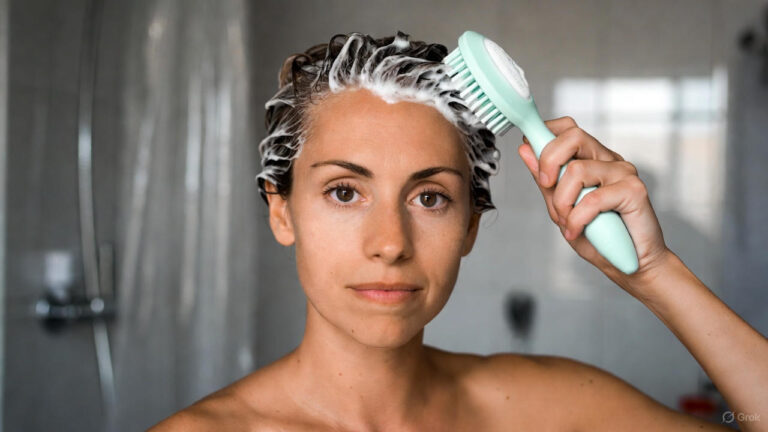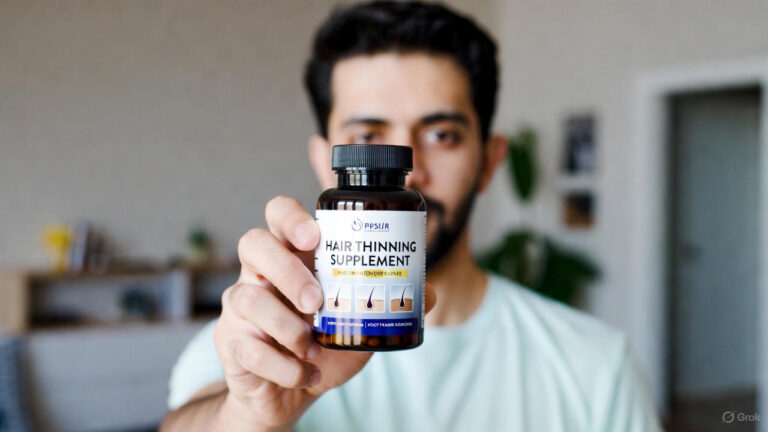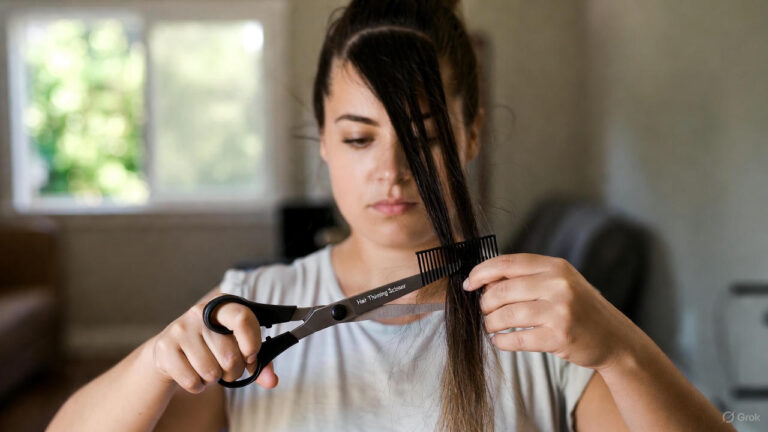When it comes to hair care, we all want hair that are not just manageable, but also healthy, shiny, and vibrant. But achieving this can be a bit challenging, given the comprehensive array of hair types and the unique needs they present.
That’s where DIY hair masks come to the rescue! These homemade treatments are not only cost-effective but also allow you to customize the ingredients to suit your specific hair type.
In this comprehensive guide, we’ll take you on a journey through the world of DIY hair masks, tailoring our recipes to suit every hair type.
I. Determining Your Hair Type
Hair types can vary widely, from oily to dry, and from straight to curly. Here’s a detailed breakdown of the different hair types:
- Oily Hair: Oily hair is characterized by an excess of natural oils produced by the scalp. This can make hair look greasy and necessitate frequent washing.
- Dry Hair: Dry hair lacks moisture and often appears dull, frizzy, or rough. It may be more prone to breakage and split ends.
- Curly Hair: Curly hair has a distinct texture, forming spirals or waves. It tends to be more susceptible to frizz and requires special care to maintain its shape.
- Straight Hair: Straight hair has a smooth, sleek texture with little natural curl or wave. It may lack volume and appear flat.
How to Identify Your Hair Type
- The Feel Test: After washing your hair with a gentle shampoo and allowing it to air dry without any product, feel the texture of your hair. Is it smooth and sleek or rough and coarse? Is there an oily residue on your fingertips?
- The Visual Test: Stand in front of a mirror and observe your hair. Does it appear greasy and flat or dry and frizzy? Are there distinct curls or waves, or is your hair mostly straight?
- The Duration Test: Take note of how often you need to wash your hair. If you find yourself washing it frequently to combat oiliness, you likely have oily hair. If you can go several days without washing and your hair remains manageable, it may be dry or of a different type.
- Ask Your Stylist: Hair professionals can offer valuable insights into your hair type. Consult with your hairstylist or a dermatologist if you’re uncertain about your hair type.
Identifying your hair type is crucial for several reasons:
- It allows you to select ingredients and DIY hair masks that specifically cater to your hair’s unique needs.
- You can avoid using products that exacerbate issues related to your hair type, such as using overly hydrating masks on already oily hair.
- Knowing your hair type helps you determine the appropriate frequency for using DIY hair masks, ensuring that you maintain a balanced and effective hair care routine.
II. DIY Hair Masks for Oily Hair
To create effective DIY hair masks for oily hair, you’ll need ingredients that balance oil production while nourishing your hair. Consider incorporating the following components:
- Lemon: Lemon juice is known for its astringent properties, making it an excellent choice for controlling excess oil on the scalp.
- Aloe Vera: Aloe vera gel soothes the scalp and helps maintain a proper pH balance, reducing excessive oil.
- Egg Whites: Egg whites are packed with protein, which strengthens hair while absorbing excess oil.
- Tea Tree Oil: Tea tree oil has natural antifungal and antibacterial properties, making it effective in combating scalp issues that contribute to oiliness.
Step-by-Step Instructions for Creating and Applying the Mask
Follow these instructions to create and apply an effective DIY hair mask for oily hair:
Lemon and Aloe Vera Mask:
- Mix 2 tablespoons of aloe vera gel with the juice of half a lemon.
- Apply the mixture to your scalp and hair, focusing on the roots.
- Leave it on for 20-30 minutes.
- Rinse thoroughly with cool water and a mild shampoo.
Egg White Mask:
- Whisk 2-3 egg whites until they become frothy.
- Apply the egg whites to your hair, focusing on the roots and scalp.
- Leave it on for 15-20 minutes.
- Rinse with lukewarm water and a gentle shampoo.
Tea Tree Oil Mask:
- Mix 5-6 drops of tea tree oil with 2-3 tablespoons of carrier oil like jojoba or olive oil.
- Apply the mixture to your scalp and hair, gently massaging it in.
- Leave it on for 30 minutes.
- Rinse thoroughly with cool water and a mild shampoo.
Benefits of the Mask for Oily Hair
Using DIY hair masks for oily hair provides several benefits:
- Regulates Sebum Production: These masks help control excess oil production on the scalp.
- Cleanses and Refreshes: They cleanse the hair and refresh the scalp, leaving it feeling lighter and cleaner.
- Strengthens Hair: Ingredients like egg whites provide essential proteins, strengthening the hair strands.
- Combats Scalp Issues: Masks with tea tree oil can help address scalp issues that contribute to oiliness.
III. DIY Hair Masks for Dry Hair
Creating effective DIY hair masks for dry hair requires ingredients that are deeply hydrating and rich in nutrients. Consider incorporating the following components:
- Avocado: Avocado is packed with healthy fats and vitamins that deeply moisturize and nourish dry hair.
- Honey: Honey is a natural humectant, meaning it attracts and retains moisture, making it an excellent choice for dry hair.
- Coconut Oil: Coconut oil is known for its hydrating properties and can penetrate the hair shaft to moisturize from within.
- Banana: Bananas are rich in potassium, natural oils, and vitamins, making them ideal for repairing and softening dry hair.
Step-by-Step Instructions for Creating and Applying the Mask
Avocado and Honey Mask:
- Mash a ripe avocado and mix it with 2 tablespoons of honey.
- Apply the mixture to your damp hair, focusing on the ends.
- Cover your hair with a shower cap and leave it on for 30-40 minutes.
- Rinse thoroughly with cool water and a mild shampoo.
Coconut Oil Mask:
- Warm 3-4 tablespoons of coconut oil until it becomes a liquid.
- Apply the warm oil to your dry hair and scalp.
- Gently massage it in and cover your hair with a shower cap.
- Leave it on for at least 1-2 hours, or overnight for intensive treatment.
- Shampoo and condition as usual.
Banana and Honey Mask:
- Blend a ripe banana with 2 tablespoons of honey until smooth.
- Apply the mixture to your hair, focusing on the ends.
- Leave it on for 20-30 minutes.
- Rinse thoroughly with cool water and a mild shampoo.
Benefits of the Mask for Dry Hair
- Deep Hydration: These masks infuse much-needed moisture into dry hair, leaving it soft and manageable.
- Reduces Frizz: Ingredients like coconut oil and honey help combat frizz and promote a smoother texture.
- Strengthens and Repairs: Avocados and bananas provide essential nutrients to strengthen and repair damaged hair.
- Promotes Shine: Dry hair can often appear dull, but these masks restore a healthy, natural shine to your hair.
IV. DIY Hair Masks for Curly Hair
To create effective DIY hair masks for curly hair, you’ll need ingredients that promote hydration, define curls, and reduce frizz. Consider incorporating the following components:
- Shea Butter: Shea butter is deeply moisturizing and helps maintain curl definition.
- Yogurt: Yogurt contains lactic acid, which can help control frizz and add shine to curly hair.
- Olive Oil: Olive oil is a natural emollient that provides hydration and enhances curl elasticity.
- Honey: Honey is a humectant that attracts moisture and promotes bouncy, well-defined curls.
Step-by-Step Instructions for Creating and Applying the Mask
Shea Butter and Olive Oil Mask:
- Melt 2-3 tablespoons of shea butter and mix it with 2 tablespoons of olive oil.
- Apply the mixture to your damp hair, focusing on the length and ends.
- Cover your hair with a shower cap and leave it on for 30-40 minutes.
- Rinse thoroughly with cool water and a mild shampoo.
Yogurt and Honey Mask:
- Mix 1/2 cup of plain yogurt with 2 tablespoons of honey.
- Apply the mixture to your damp hair, ensuring even coverage.
- Leave it on for 20-30 minutes.
- Rinse thoroughly with cool water and a mild shampoo.
Benefits of the Mask for Curly Hair
- Defined Curls: These masks help define and maintain your natural curl pattern.
- Reduces Frizz: Ingredients like shea butter and olive oil reduce frizz, leaving your curls smoother.
- Nourishes and Hydrates: Curly hair often needs extra moisture, and these masks provide essential hydration.
- Promotes Elasticity: Honey helps maintain the elasticity of your curls, ensuring they spring back into shape.
V. DIY Hair Masks for Straight Hair
Creating effective DIY hair masks for straight hair involves ingredients that provide strength, shine, and nourishment while keeping the hair smooth and manageable. Consider incorporating the following components:
- Amla Powder: Amla, or Indian gooseberry, is rich in vitamins and antioxidants that promote hair health and shine.
- Almond Oil: Almond oil is a lightweight and non-greasy oil that adds shine and nourishment to straight hair.
- Hibiscus: Hibiscus flowers are known for their hair-strengthening properties and ability to prevent hair fall.
- Egg Yolks: Egg yolks are rich in protein and vitamins, providing strength and vitality to straight hair.
Step-by-Step Instructions for Creating and Applying the Mask
Amla Powder Mask:
- Mix 2-3 tablespoons of amla powder with enough water to form a thick paste.
- Apply the paste to your hair and scalp, ensuring even coverage.
- Leave it on for 30-40 minutes.
- Rinse thoroughly with cool water and a mild shampoo.
Almond Oil Mask:
- Warm 3-4 tablespoons of almond oil until it becomes a comfortable temperature.
- Apply the warm oil to your hair, focusing on the mid-lengths and ends.
- Massage the oil into your hair and scalp, ensuring it’s evenly distributed.
- Leave it on for at least 30 minutes.
- Shampoo and condition as usual.
Hibiscus and Egg Yolk Mask:
- Blend a handful of hibiscus flowers with 2 egg yolks until smooth.
- Apply the mixture to your hair and scalp.
- Leave it on for 30-45 minutes.
- Rinse thoroughly with cool water and a mild shampoo.
Benefits of the Mask for Straight Hair
- Adds Shine: These masks enhance the natural shine of straight hair, making it look healthier and more radiant.
- Strengthens Hair: Ingredients like amla powder and egg yolks provide essential proteins and vitamins that strengthen the hair strands.
- Prevents Hair Fall: Hibiscus is known for its hair-strengthening properties, reducing hair fall.
- Nourishes and Protects: Almond oil nourishes and protects the hair while maintaining its sleek appearance.
VI. Common Ingredients for All Hair Types
Certain ingredients possess versatile properties that make them suitable for DIY hair masks catering to various hair types. These common elements can be seamlessly integrated into your DIY hair mask recipes. Here are some ingredients that work for all hair types;
- Olive Oil: Olive oil is a multipurpose ingredient that offers deep hydration, shine, and nourishment. It is rich in antioxidants and healthy fats, making it ideal for all hair types.
- Honey: Honey is a natural humectant, attracting and retaining moisture, which benefits both dry and oily hair types. It also provides shine and softness to the hair.
- Aloe Vera: Aloe vera is known for its soothing properties and can help balance the scalp’s pH, making it a versatile choice for all hair types.
- Yogurt: Yogurt contains lactic acid, which cleanses the scalp and provides essential nutrients for healthier hair, making it a universal ingredient.
- Coconut Oil: Coconut oil is celebrated for its ability to penetrate the hair shaft, delivering deep hydration and reducing frizz, making it suitable for all hair types.
Note: While these common ingredients are generally safe for all hair types, it’s essential to perform a patch test to check for allergies or reactions, especially if you have sensitive skin or a history of allergies. If you notice any adverse reactions, discontinue use and consult a dermatologist. Additionally, always follow the recommended proportions and instructions in your DIY hair mask recipes to avoid overuse or potential negative effects.
VII. Tips for Applying and Maintaining DIY Hair Masks
A. Proper Application Techniques
- Damp Hair: Apply your DIY hair mask to clean, damp hair. Damp hair allows for better product absorption.
- Sectioning: For even distribution, section your hair into manageable parts before applying the mask. Focus on the roots and work your way down to the tips.
- Massage In: Gently massage the mask into your hair and scalp using circular motions. This enhances blood circulation, allowing nutrients to penetrate more effectively.
- Use a Shower Cap: To create a controlled environment that promotes better absorption, cover your hair with a shower cap. This traps heat, helping the mask penetrate deeply.
- Time Matters: Follow the recommended duration for the mask you’re using. Typically, 20-45 minutes is sufficient. Avoid overextending the time, as it may lead to dryness or product buildup.
B. Frequency of Application
- Oily Hair: Use DIY hair masks for oily hair once a week to prevent overstimulating the sebaceous glands.
- Dry Hair: Apply DIY hair masks for dry hair once or twice a week, depending on the level of dryness, to maintain optimum moisture.
- Curly Hair: Utilize DIY hair masks for curly hair every 1-2 weeks to retain moisture and define your curls.
- Straight Hair: Apply DIY hair masks for straight hair every 2 weeks to maintain a balance between nourishment and avoiding excessive weight.
C. Post-Mask Care and Maintenance
- Rinse Thoroughly: After leaving the mask on for the recommended time, ensure thorough rinsing to prevent any product buildup.
- Use Mild Shampoo: Opt for a gentle, sulfate-free shampoo to cleanse your hair without stripping away the natural oils.
- Follow with Conditioner: Apply a lightweight conditioner to seal the cuticles and lock in the moisture from the hair mask.
- Air Dry or Low Heat: Allow your hair to air dry whenever possible, or use a low-heat setting if blow-drying, to minimize heat damage.
Frequently Asked Questions
1. Which hair mask is best for all hair types?
The DIY hair mask that works for all hair types usually includes ingredients such as aloe vera, coconut oil, and honey. These elements provide essential nourishment and hydration, making them suitable for various hair types.
2. What is a good hair mask homemade?
A good homemade hair mask often includes natural ingredients like avocado, olive oil, and egg yolks. These components help in nourishing and strengthening your hair, leaving it soft, smooth, and well-moisturized.
3. Are hair masks for all hair types?
Yes, hair masks can be customized to cater to different hair types, including oily, dry, curly, and straight hair. By selecting the right ingredients, you can create DIY hair masks that address specific hair concerns and promote overall hair health.
4. What is the best homemade hair mask for hair growth?
For promoting hair growth, a homemade hair mask with ingredients like castor oil, amla powder, and fenugreek seeds can work wonders. These components stimulate the scalp, improve blood circulation, and nourish the hair follicles, fostering healthy and robust hair growth.
5. What ingredient grows hair fastest?
Among the various ingredients, onion juice is known for promoting hair growth. Its high sulfur content helps improve blood circulation to the hair follicles, promoting hair growth and preventing hair fall.
6. Can rice water grow hair?
Yes, rice water is known for its hair-strengthening properties. It contains vitamins and minerals that nourish the hair, making it stronger and promoting hair growth.
7. Can I spray rice water on my hair every day?
It’s recommended to use rice water on your hair 2-3 times a week for optimal results. Using it daily might lead to protein overload, which can cause dryness and brittleness in the hair.
8. What are the negatives of rice water for hair?
Using rice water excessively or without proper dilution can lead to protein overload, causing dryness and brittleness. It’s essential to use rice water in moderation and follow proper dilution guidelines to avoid any adverse effects.
9. How can I make my African hair grow faster?
To promote hair growth in African hair, use a combination of natural oils such as coconut oil, castor oil, and shea butter. These oils provide essential nourishment and moisture, aiding in faster hair growth and maintaining hair health.



